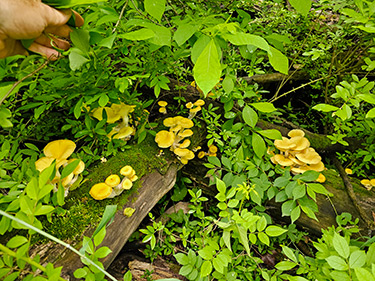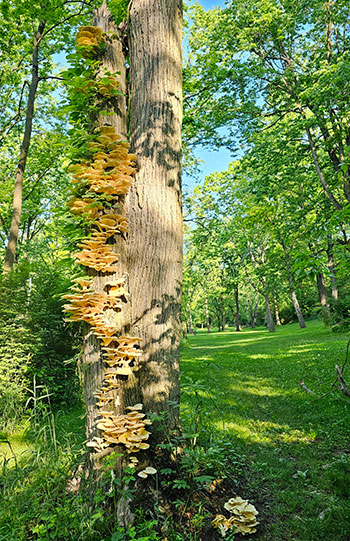Pleurotus citrinopileatus
Scientific name: Pleurotus citrinopileatus Singer
Derivation of name: Pleur- means "side" and otus means
"ear" referring to the off-center stalk or laterally
attached
stipe of some species in the genus. Citrino means "lemon-
colored" and pileatus means "capped."
Synonyms: Pleurotus cornucopiae var. citrinopileatus
(Singer) Ohira; Pleurotus cornucopiae subsp.
citrinopileatus (Singer) O. Hilber
Common name(s): Golden oyster.
Phylum: Basidiomycota
Order: Agaricales
Family: Pleurotaceae
Occurrence on wood substrate: Saprobic; clustered on
decaying hardwoods such as oak, elm, and beech; spring
through early fall.
Dimensions: Caps 2-6.5 cm wide; stipes 2-5 cm long and
2-8 mm thick.
Cap: Young caps are typically funnel-shaped and
bright yellow to golden-brown. With age, caps may fade
to almost whitish and become flatter in shape.
Gills: Decurrent; ivory-white.
Spore print: Pale pinkish.
Stipe: White; often curved or bent, often branched.
Veil: Absent. A membranous partial veil is present in
the mushroom primordium but disappears quickly with
growth.
Comments: Apparently, this is the first known
cultivated mushroom species that has escaped cultivation
(commercial and/or at-home cultivation)
and become
naturalized. Cultivation of Pleurotus citrinopileatus in
North America started around 2000 and the first report
of its naturalized occurrence was in 2012.
There are
many iNaturalist reports of this species from parts of the
Midwest (e.g., Minnesota, Iowa, Wisconsin,
Illinois,
Michigan, Ohio) and eastern states such as Delaware,
Maryland, Pennsylvania, New York, and Massachusetts.
The species is native to subtropical hardwood forests
of
eastern Russia, northern China, and Japan. Due to its
preference for warm temperatures, its northern range in
North America remains uncertain.
More information at Wikipedia.org

Figure 1.
Pleurotus citrinopileatus. See comments above
about this cultivated Asian species which has become
naturalized.
Photo © George Morrison.

Figure 2. Strikingly yellow golden oyster mushrooms
growing on a log in eastern PA.
Photo © George Morrison.

Figure 3. When growing laterally on a substrate, the stems
are often bent or curved and the stem position is eccentric.
Photo © George Morrison.

Figure 4.
The stems are clustered, often originating from
a common base. Photo © George Morrison.

Figure 5. Here we have non-native Pleurotus citrinopileatus
decomposing
an
ash tree killed by the non-native emerald
ash borer. Photo © George Morrison.

Figure
6. This picture, taken in 2024, is of the same
dead elm tree as in Figure 5, only one year later and
with many more golden oyster mushrooms.
Photo © George Morrison.

Figure 7. The decurrent gills of Pleurotus citrinopileatus
are described as ivory-white. I suspect the slight pinkish
tint of these mature gills is due to the pale-pinkish spores
of this species.
Photo © Kathy Snyder.

Figure 8. Young fruit bodies of Pleurotus citrinopileatus are
strongly funnel-shaped due to their elongate shape and
the manner in which the centers of the caps are depressed or
indented.
Photo © Tim and Christina Smith.

Figure 9. On display at a NEMF foray: Cultivated Pleurotus
citrinopileatus growing
from an organic substrate in a
plastic bag.
Photo © Gary Emberger.